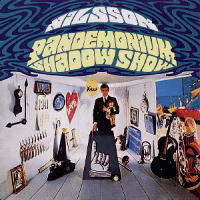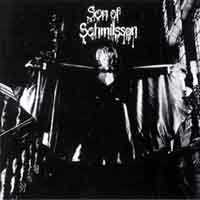Ladies and gentlemen, in the center ring, presenting NILSSON, and his Shandemanium Shadow Poe!
Ha ha ha! And his Shande…ha! Shadrach, Meshach, Abednego!
And so, even before the opening notes of his debut album, Harry Nilsson made sure his audience knew what it was in for–the sound of an hysterical carnival barker, mangling the album’s title before dissolving into peals of maniacal laughter. It was probably a jab at Nilsson’s label–he wanted to call the album Something Wicked This Way Comes, but it was overruled as being too sinister–and, if so, it set the tone for relations between the artist and RCA for the duration of Nilsson’s career. Audiences around the world would be the beneficiaries.

Pandemonium Shadow Show (1967)
As debut albums go, Pandemonium Shadow Show is fairly auspicious. Though the production reeks of late ’60s madness (”There Will Never Be,” in particular, sounds today like something from an Austin Powers shag party), the songs are pin-sharp and impeccably performed; an appealing mixture of ornately baroque and endearingly ragged. A perfect example of both elements is “She Sang Hymns Out of Tune,” which features Harry entering a chorus a few bars early. The material doesn’t take full advantage of Nilsson’s three-and-a-half-octave tenor–audiences would have to wait a few years to really understand what a phenomenal vocal talent he was–but it was a batch of songs strong enough to attract the attention of a small army of discerning pop fans. Among them–perhaps attracted by Pandemonium’s brilliant three-minute Beatles pastiche “You Can’t Do That”–were John Lennon and Paul McCartney.
At the press conference for the launch of Apple Records, John Lennon and Paul McCartney were asked, “Who’s your favorite American singer?” They replied “Nilsson.”
They were then asked, “Who’s your favorite American band?” They replied “Nilsson.”
At the time, Nilsson was working at a bank, and though the notoriety he gained through his Lennon/McCartney connection didn’t translate into enormous sales, it did give him enough confidence to quit his day job. There was no looking back.
Harry Nilsson – She Sang Hymns Out of Tune
Harry Nilsson – You Can’t Do That
Harry Nilsson – Cuddly Toy
Aerial Ballet continues the crucial themes of Pandemonium–paternal abandonment, loneliness, alienation–all couched in melodies and arrangements so catchy, so beautiful, that it’s easy to miss completely the subject matter. He tackles suicide on “I Said Goodbye to Me,” thumbs his nose at fleeting fame on “Mr. Richland’s Favorite Song,” and, on “Bath” and “Good Old Desk,” writes possibly the only two adult pop songs about a desk and taking a bath. “One” (as in “the loneliest number there could ever be”) was a hit for Three Dog Night, helping to cement Nilsson’s status as a songwriter’s songwriter (and line his pocketbook).
Ironically, Aerial Ballet’s big hit, “Everybody’s Talkin’,” was written by the semi-obscure singer/songwriter Fred Neil, not Harry. He was never averse to doing covers–in fact, as time went on, some of his most compelling recordings were written by others–yet one can’t help but think it took a little of the shine off Nilsson’s brass ring. Then again, his next release would be nothing but covers, so maybe it didn’t bother him at all.
Harry Nilsson – Mr. Richland’s Favorite Song
Harry Nilsson – Everybody’s Talkin’
Harry Nilsson – One
Nilsson Sings Newman stands out in Nilsson’s catalog for several reasons: One, it’s comprised entirely of Randy Newman covers; two, it features nothing but Newman’s piano and Nilsson’s angelic, multi-tracked voice; three, it represents a once-in-a-lifetime convergence of two of the decade’s greatest musical talents.
The set isn’t without problems, however. Chief among them is the fact that the characters who tend to populate Randy Newman songs–ungrateful sons, murderers, racists, unrepentant drunks–are decidedly imperfect, and therefore best represented by an imperfect voice. Newman’s own froggy croak is perhaps the best example. Nilsson was a helluva singer, and possessed a wicked sense of humor, but for quite a bit of this album, he sounds an awful lot like a choirboy who has been tricked into putting on his Sunday best to sing sheet after sheet of profanity. It would take time, copious amounts of alcohol, and years of casual abuse before Nilsson’s vocals grew into this kind of material. Arguably the best performances recorded during these sessions were left off the album, only to resurface with the 30th Anniversary reissue.
Harry Nilsson – I’ll Be Home (demo)
Harry Nilsson – Love Story (demo)
After his first three releases sold poorly, Nilsson knew it was make-or-break time–in order to keep making the music he loved, he needed a hit. In search of a new sound, he drafted producer Richard Perry, which turned out to be the perfect choice. Perry brought a kitchen-sink approach to his productions, rarely settling for one guitar when four would do, and managed to beautifully meld the pure clarity of Harry’s voice with a beefed-up sound that could ably serve their louder inclinations. Longtime Nilsson fans were doubtless shocked by the seven-minute-plus “Jump into the Fire,” a reverb-laden piece of rock & roll insanity that crested the charts in an unfortunately edited state. It was a whole new Nilsson, surely, but one that sounded like–for the first time–the real Nilsson. Whether it’s the old alcoholic on “Gotta Get Up,” or the weary commuter of “Driving Along,” or the spurned lover of “Early in the Morning,” these were the most three-dimensional characters, and the best songs, Harry had written.
And then, of course, there was “Without You,” a song Nilsson and Perry nicked from Badfinger’s Pete Ham. Played to death at the time, and covered since by everyone from Air Supply to Mariah Carey, “Without You” propelled Nilsson Schmilsson to smash-hit status and made Harry a star in his own right. Unfortunately, it also cemented him in the minds of radio programmers as a crooning balladeer, setting in motion a struggle he’d endure for the last half of his career. It’s a beautiful song, but everyone’s heard it a million times already, so we don’t need to include it here.
Harry Nilsson – Gotta Get Up
Harry Nilsson – Jump into the Fire
Pressed into releasing a follow-up to his biggest hit while the iron was still hot, Nilsson responded with Son of Schmilsson. Though Nilsson Schmilsson had managed to bring together all the wildly disparate elements of Harry’s lyrical and musical loves, Son made it pale by comparison. It’s a conflicted album by a conflicted artist–fighting his label, desirous of continued success, and entering the early stages of burnout, Harry was just as likely to write and record a lovely, chart-ready ballad like “Remember” as he was to mock that very song by belching into the microphone. The album is replete with humor, from the tongue-in-cheek title to the between-song skits; unfortunately for Nilsson, much of it is of the scatological variety.
Most of Son’s jokes seem tame by modern standards–the line “I sang my balls off for you, baby,” in “Take 54,” for instance–yet large portions of Nilsson’s audience, expecting another “Without You,” were put off by them. And then there’s the piece de resistance, “You’re Breakin’ My Heart.” Still arguably the breakup song to end all breakup songs, it includes the instantly memorable chorus, “You’re breakin’ my heart/You’re tearin’ it apart/So fuck you.” Any easily offended listener who bothered to make it to the end of the album was treated to “I’d Rather Be Dead,” in which Harry leads a chorus of retirement home residents in singing “I’d rather be dead/Than wet my bed.”
It’s a shame, really, because in many ways, Son is a stronger album than its predecessor. But the long-festering battle between Nilsson and RCA had become a war.
Harry Nilsson – The Lottery Song
Harry Nilsson – Turn On Your Radio
Harry Nilsson – You’re Breaking My Heart








Comments